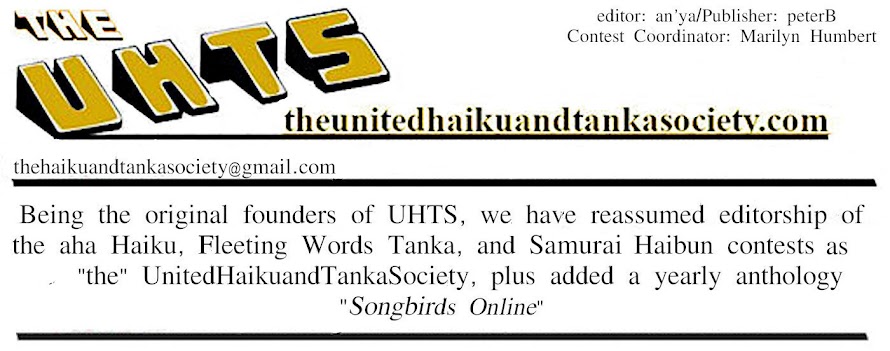SEE THE SUBMISSIONS GUIDELINES BELOW THIS ARTICLE
Sedōka is an authentic but uncommon Japanese poetry genre from the 8th century. Its style of composition was created by a venerated Japanese court poet, who was known as Japan’s first great literary figure, Kakinomoto no Hitomaro. This is one of his question-response dialogue Sedōka with English translation published in the Man’yōshū:
If the thunder rolls for a while
And the sky is clouded, bringing rain,
Then you will stay beside me?
Even when no thunder sounds
And no rain falls, if you but ask me,
Then I will stay beside you.
Kakinomoto no Hitomaro, Japan
The Sedōka has not been in widespread use for centuries now. Perhaps this may be because it’s a sophisticated concept to grasp, and best suited for esoteric poets. Thus, with the following article, comes a challenge to expand your writing skills and include this genre by submitting to the United Haiku and Tanka Society’s Sedōka Songbirds Journal online, the first of its kind to publish this genre exclusively.
A Sedōka consists of 2 tercets (three line verses) as a question-response exchange between lovers, a question-answer learning tool between mentor and student, or it can also be two 3-line reflective verses by one poet that juxtapose. This form consists of an image in the top tercet, usually drawn from nature, followed by 3 lower lines that enhance the meaning and share the author’s deeper perspective. Another form of Sedōka is one where the head, or (line 1) in the upper verse is repeated in (line 1) of the lower verse. In every style, each 3-line verse should be able to stand alone.
Structurally, a tercet can be either like Western haiku, consisting of 5/7/5, or like a tanka count of 5/7/7 in English syllables, or nowadays composed as condensed versions in appreciation of the shorter Japanese on (sound unit). This way, it still represents and respects both cultures while maintaining a song-like melody, for instance, a 4/6/4 or a 3/5/3 haiku format, or a 4/6/6 or a 3/5/5 tanka format. As to what themes Sedōka uses, natural imagery and concepts of romantic, spiritual, or reflective musings appear most often.
My first Sedōka example is a reflective form, English language tanka showing the style of 5/7/7:
Here is another similar version of this Sedōka which is shortened to a 4/6/6 tanka style to compensate for English language syllables versus Japanese sound units:
red sky at night
the prophesy of dreams–
sleep befell me
shepherd, sailor
I woke to the delight...
a biblical sunrise
No matter which style this Sedōka uses, it takes on the same meaning. The upper verse sets up the image and a prediction per that old saying “a red sky at night”, which originated first for a shepherd in the Bible and later was applied to predicting the weather for sailors. The lower verse deepens the top verse, and the reader is free to share the poet’s perspective.
This next Sedōka example is a question-response between two lovers, a condensed haiku style of a 3/5/3 structure, which still keeps the songful rhythm:
why is it
so long you’ve been lost
in a fog
patience love
spring sun shall show what
you wait for…
Here is another similar version of my question-response Sedōka that shows how to use the 5/7/7 English language tanka style by simply elaborating on the theme:
why is it so long
since you’ve been lost in a fog
when will all come clear again
be patient my love
the spring sun shall soon reveal
what you are waiting for…
In both versions of this Sedōka, the upper verse simply poses a question of waiting for something or someone, and hints at the season. The lower verse provides an obscure yet elaborate answer by a lover. In this case, only the reader can interpret or imagine what the first person has been waiting for; we know only that whatever the answer is, it shall be revealed by the spring sun.
This third example is the Sedōka style in a tanka format of 5/7/7 where the head (first line) question is repeated with an answer:
where would my love dwell
if ever she existed
for me in this universe
my love would dwell where
waves caress the ocean rocks
and a mermaid calls my name
an’ya,USA
Here is a final example of a question-answer Sedōka also, but it’s between mentor and student and uses a condensed tanka style of 4/6/6 English syllables:
O my mentor
how does one learn answers
to the questions he seeks
wisdom is but
stars in a bucket pulled
from the depths of one's well
an'ya, USA
-------
Submissions for our new Wing of the United Haiku and Tanka Society’s Premier Edition of Songbirds Sedōka Journal are open from 1 November 2023 until 1 December 2023. (midnight) GMT.
Take the Challenge and Become a Sedōka Songbird
Submission Guidelines
1. Please send your work in the body of an email only, with no attachments, and be sure to include your country, name, and email address.
2. Only works that have never been previously published will be considered.
3. Works submitted elsewhere simultaneously will not be considered.
4. Submit up to 5 Sedōka that follow closely the explanation of this genre above.
5. Works must be submitted in English using the suggested format for Sedōka per the examples above.
6. Poets should be open to considering constructive suggestions and workshopping.
7. Works that will not be considered, please do not submit mainstream short-form poems, and be sure to read the article above in depth.
Response Time: Within 2 weeks of submitting, and if you don’t hear back by then, please resend. Submit your work with the subject heading of SONGBIRDS SEDOKA SUBMISSIONS to an’ya via:
theunitedhaikuandtankasociety@gmail.com or tankaanya@gmail.com
Copyright Policy: All rights revert back to authors upon publication, although credits for having been first published in Songbirds Sedōka Journal, are required.

